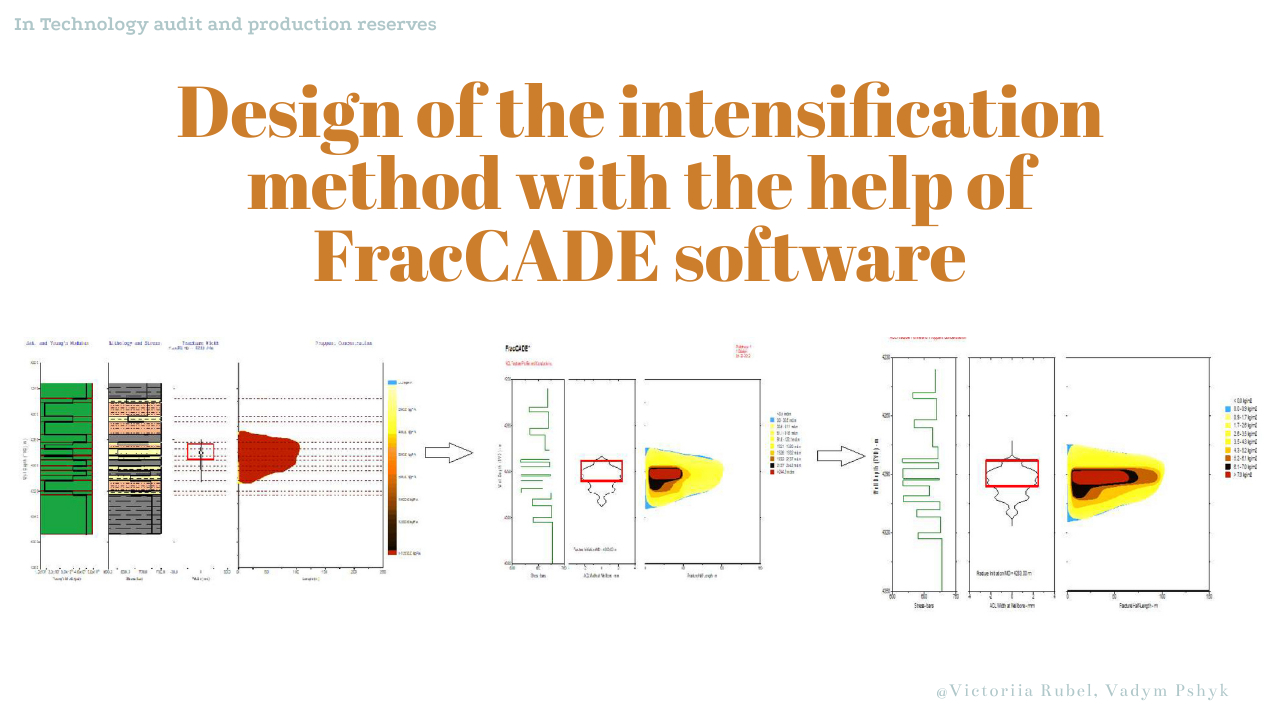Design of the intensification method with the help of FracCADE software
DOI:
https://doi.org/10.15587/2706-5448.2024.300264Keywords:
FracCADE, hydraulic fracturing, fracture, permeability, proppant, viscosity, well, productive horizonAbstract
The object of research in the work is the FracCADE software, with which it is possible to simulate the process of hydraulic fracturing and well field, on which the intensification method is designed. This hydraulic fracturing simulator was developed by Schlumberger Ltd. based on proven physical principles of hydraulic fracturing to optimize the treatment process and proven in practice. The system includes a range of hydraulic fracturing models, from 2D models to extensive 3D simulations with lateral communication. It includes a number of complementary modules for fracturing fluid and proppant optimization, injection scheduling, real-time monitoring, pressure equalization, production forecasting and economic evaluation. Some models allow simulating the geometry of the fracture, solving proppant concentration problems, and simulating possible shielding due to proppant covering the fracture or the dehydration process.
Hydraulic fracturing remains one of the main engineering tools for increasing the productivity of wells. The effect is achieved due to:
– creation of a conductive channel (fracture) through the damaged (contaminated) zone around the well, in order to penetrate beyond its boundaries;
– spreading of the channel (fracture) in the formation to a considerable depth in order to further increase the productivity of the well;
– creation of a channel (fracture), which would allow changing, influencing the fluid flow in the formation.
In the latter case, fracturing really becomes an effective tool that allows to manage the operation of the reservoir (in particular, change its filtering characteristics) and implement long-term strategic development programs. The concept of hydraulic fracturing is quite simple. In general, for relatively simple geology, the physical foundations of fracturing theory are fairly well developed and tested. For the most part, the difficulties boil down to two problems: the real geological conditions and the complex multidisciplinary nature of the fracturing process itself.
The process of designing fracturing in order to achieve a certain result is closely related to rock mechanics (which affects the geometric parameters of the fracture), fluid hydromechanics (in which the tasks of controlling the flow of the working fluid and placing the proppant in the fracture are solved) and chemistry, which determines the behavior of materials, which are used during hydraulic fracturing. Moreover, the hydraulic fracturing project must take into account the physical limitations imposed by the specifics of the real deposit and well. In addition, to achieve the desired results, the fracturing operation must be carried out in strict accordance with the calculations (that is, a complete cycle in which each operation plays its role).
References
- Davis, J. R., Edgar, T. F. (2015). A Practical Guide to Process Intensification. Wiley.
- Kristanto, D., Jagadita, I. S. (2021). An Integrated Analysis for Post Hydraulic Fracturing Production Forecast in Conventional Oil Sand Reservoir. Journal of Earth Energy Engineering, 10 (1), 1–17. doi: https://doi.org/10.25299/jeee.2021.5024
- Petruniak, M., Rubel, V., Chevhanova, V., Kulakova, S. (2021). Application of grout slurries with the defecate addition for effective well cementing. Mining of Mineral Deposits, 15 (1), 59–65. doi: https://doi.org/10.33271/mining15.01.059
- Page, J. C., Miskimins, J. L. (2009). A Comparison of Hydraulic and Propellant Fracture Propagation in a Shale Gas Reservoir. Journal of Canadian Petroleum Technology, 48 (5), 26–30. doi: https://doi.org/10.2118/09-05-26
- Ektefa, G., Shahbazi, K. (2020). Hydraulic fracturing process in tight base shale of asmari formation in Ahwaz Oilfield. Journal of Petroleum Science and Technology, 10 (2), 49.
- Budiharjo Sulistyarso, H. (2019). Effect of Pump Rate Penetration Sensitivity on Hydraulic Fracturing in Low Resistivity Reservoir. Petroleum Science and Engineering, 3 (1), 10. doi: https://doi.org/10.11648/j.pse.20190301.13
- Ramadhan, D., Tulloh, H., Julianto, C. (2020). Analysis Study Of The Effect In Selecting Combination Of Fracturing Fluid Types And Proppant Sizes On Folds Of Increase (FOI) To Improve Well Productivity. Journal of Petroleum and Geothermal Technology, 1 (2), 92–99. doi: https://doi.org/10.31315/jpgt.v1i2.3886
- Ahmed, A. A., Bayoumi, A. W. A. H. (2023). Improving Hydraulic Fracturing Productivity in Khalda Oil Fields (Western Desert-Egypt). Journal of Physics: Conference Series, 2594 (1), 012001. doi: https://doi.org/10.1088/1742-6596/2594/1/012001
- Fairhurst, D. L., Marfice, J. P., Seim, M. R., Norville, M. (2000). Completion and Fracture Modeling of Low-Permeability Gas Sands in South Texas Enhanced by Magnetic Resonance and Sound Wave Technology. Proceedings of SPE/CERI Gas Technology Symposium. doi: https://doi.org/10.2523/59770-ms
- Chandra, S., Daton, W. N., Herlambang, S. A., Aziz, P. A. (2023). Optimizing hydraulic fracturing operation on water dominated geothermal reservoir: A case study of well X in Indonesia. AIP Conference Proceedings. AIP Publishing, 2598 (1). doi: https://doi.org/10.1063/5.0134885

Downloads
Published
How to Cite
Issue
Section
License
Copyright (c) 2024 Victoriia Rubel, Vadym Pshyk

This work is licensed under a Creative Commons Attribution 4.0 International License.
The consolidation and conditions for the transfer of copyright (identification of authorship) is carried out in the License Agreement. In particular, the authors reserve the right to the authorship of their manuscript and transfer the first publication of this work to the journal under the terms of the Creative Commons CC BY license. At the same time, they have the right to conclude on their own additional agreements concerning the non-exclusive distribution of the work in the form in which it was published by this journal, but provided that the link to the first publication of the article in this journal is preserved.







